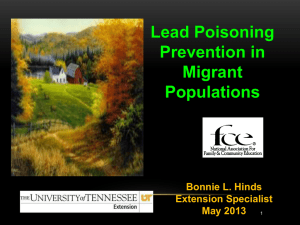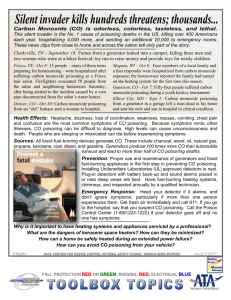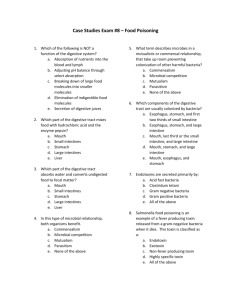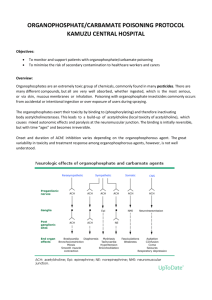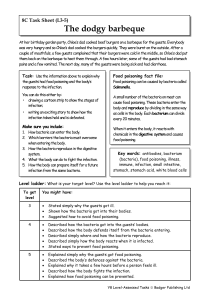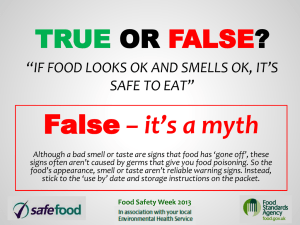Learning outcome #1 - Gulf Coast State College
advertisement
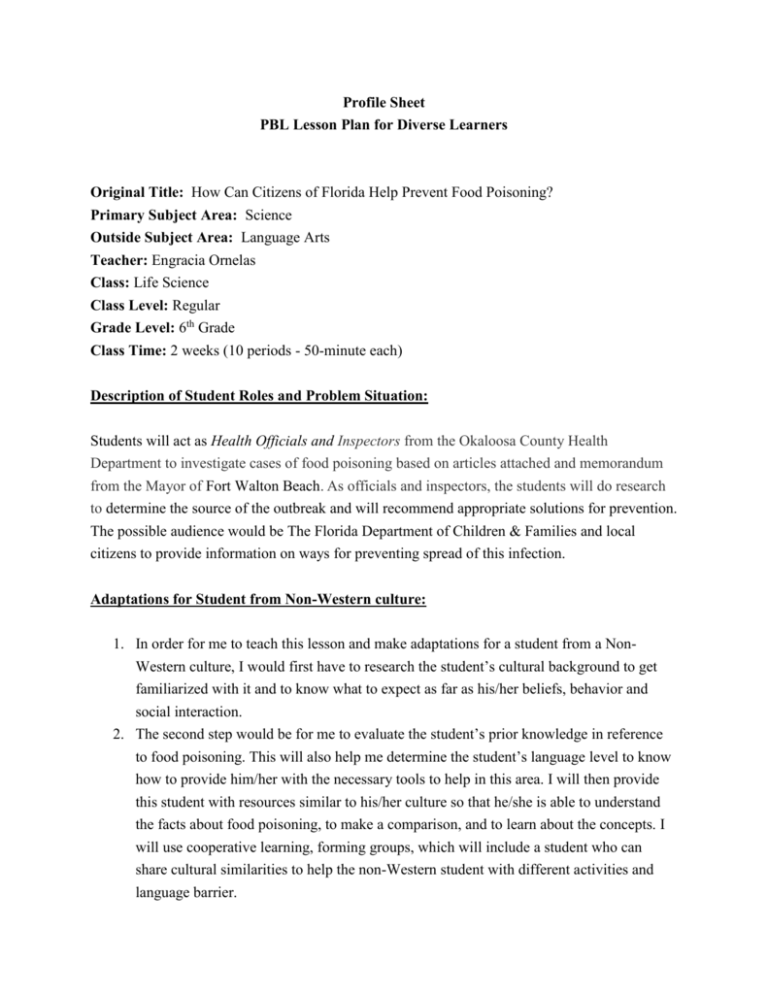
Profile Sheet PBL Lesson Plan for Diverse Learners Original Title: How Can Citizens of Florida Help Prevent Food Poisoning? Primary Subject Area: Science Outside Subject Area: Language Arts Teacher: Engracia Ornelas Class: Life Science Class Level: Regular Grade Level: 6th Grade Class Time: 2 weeks (10 periods - 50-minute each) Description of Student Roles and Problem Situation: Students will act as Health Officials and Inspectors from the Okaloosa County Health Department to investigate cases of food poisoning based on articles attached and memorandum from the Mayor of Fort Walton Beach. As officials and inspectors, the students will do research to determine the source of the outbreak and will recommend appropriate solutions for prevention. The possible audience would be The Florida Department of Children & Families and local citizens to provide information on ways for preventing spread of this infection. Adaptations for Student from Non-Western culture: 1. In order for me to teach this lesson and make adaptations for a student from a NonWestern culture, I would first have to research the student’s cultural background to get familiarized with it and to know what to expect as far as his/her beliefs, behavior and social interaction. 2. The second step would be for me to evaluate the student’s prior knowledge in reference to food poisoning. This will also help me determine the student’s language level to know how to provide him/her with the necessary tools to help in this area. I will then provide this student with resources similar to his/her culture so that he/she is able to understand the facts about food poisoning, to make a comparison, and to learn about the concepts. I will use cooperative learning, forming groups, which will include a student who can share cultural similarities to help the non-Western student with different activities and language barrier. Adaptations for ESOL Student: 1. I will help the ESOL student by using written resources in his/her first language. This can be accomplished by using technology, the Internet, and different programs for practice or translation. 2. I will also assign another student to the ESOL student to help gather information for the presentation and to provide the non-Western student with any assistance needed in his own language to accomplish the task. Title, Learner Characteristics, NGSSS Teacher: Engracia Ornelas Primary Subject Area: Science Outside Subject Area: English Language Arts Class: Life Science Class Level: Regular Grade Level: 6th Grade PBL Title: How Can Citizens of Florida Help Prevent Food Poisoning? NGSSS in Science: SC.6.L.14.6: Compare and contrast types of infectious agents that may infect the human body, including viruses, bacteria, fungi, and parasites. SC.6.L.14.5: Identify and investigate the general functions of the major systems of the human body (digestive, respiratory, circulatory, reproductive, excretory, immune, nervous, and musculoskeletal) and describe ways these systems interact with each other to maintain homeostasis. CCSS: in English Language Arts: LACC.6.W.3.7: Draw evidence from literary or informational texts to support analysis, reflection, and research. Learners Characteristics: Learner Characteristics #1: Physical – Physical growth tends to be both rapid and uneven (Snowman, p. 89). Justification for #1: Differences in physical maturity among boys and girls can affect differences in behavior. For example, girls mature more rapidly than boys and show characteristic of wide range of interests, and early maturity in boys show characteristics of selfconfidence, and responsibility, this allows them to be more sociable and cooperative to participate with others. Therefore, it is very important for the teacher to have students participate within heterogeneous groups to interact with each other to share opinions and learning strategies. Learner Characteristics #2: Social – The desire to conform reaches a peak during the middle school years (Snowman, p.91). Justification for #2: The fact that in this stage students are concerned with receiving social approval from others, they can become influenced by their peers, and peer group becomes their source for rules and behavior. Participating within different groups will be important in this PBL plan because students can share different views, and it will also help them develop social skills. Learner Characteristics #3: Emotional –As a result of the continued influence of egocentric thought, middle school students are typically self-conscious and self-centered (Snowman, p. 93). Justification for #3: Confusion, anxiety, and mood swings are due to growth, and transition from elementary to middle school. As a result from all of these physical and emotional changes, peer value, appearance, feelings, and behavior are all very important for these students and therefore they become self-conscious and self-centered. Since students in this stage feel more comfortable being around their peer group, for this lesson plan the teacher needs to find ways to provide a classroom atmosphere in which students can participate with others to meet their social and emotional needs. Learner Characteristics #4: Cognitive – Because of the psychological demands of early adolescence, middle school students need a classroom environment that is open, supportive, and intellectually stimulating (Snowman, p.94). Justification for #4: Due to physical changes, transition from elementary to middle school, and cognitive development, students’ academic motivation decline. Therefore, it will be important in this PBL problem to provide students with a supportive classroom environment in which they can meet their social, emotional and cognitive needs. Learner Characteristics #5: Social –Self-efficacy becomes an important influence on intellectual and social behavior (Snowman, p. 97). Justification for #5: Students decide either to accomplish a task or give up on it depending on how difficult the task becomes, or depending on the student’s level of self-efficacy. Therefore it is very important for the teacher to know how to use persuasion, modeling, imitation, learning strategies, and effective forms of instruction to help students develop a strong feeling of selfefficacy because it plays a big role in intellectual and social behavior. Interdisciplinary Learning Outcomes; Student Role & Problem Situation; Meet the Problem NGSSS in Science: SC.6.L.14.6: Compare and contrast types of infectious agents that may infect the human body, including viruses, bacteria, fungi, and parasites. Learning outcome #1: Searching for types of bacteria that can lead to food poisoning, students will be divided into groups and each student will compare possible type of bacterial pathogen and will share with the class ways in which it could infect the human body. Students must score satisfactory on the rubric. (Analysis) SC.6.L.14.5: Identify and investigate the general functions of the major systems of the human body (digestive, respiratory, circulatory, reproductive, excretory, immune, nervous, and musculoskeletal) and describe ways these systems interact with each other to maintain homeostasis. Learning Outcome #2: Learning about the various types of food poisoning and the effect these can have in individuals, each student will conclude which type of bacteria can do more harm to the human body. Students must score satisfactory on the rubric. (Analysis) LACC.6.W.3.7: Draw evidence from literary or informational texts to support analysis, reflection, and research). Learning Outcome #3: Using information from their research, each student will elaborate on their findings and will provide a possible solution for preventing food poisoning. Students must score satisfactory on the rubric. (Synthesis) Description of Student Roles and Problem Situation: Students will act as Health Officials and Inspectors from the Okaloosa County Health Department to investigate cases of food poisoning based on articles attached and memorandum from the Mayor of Fort Walton Beach. As officials and inspectors, the students will do research to determine the source of the outbreak and will recommend appropriate solutions for prevention. The possible audience would be The Florida Department of Children & Families and local citizens to provide information on ways for preventing spread of this infection. Meet the Problem Method: Students will receive a memo from the Mayor of City of Fort Walton Beach (see attached) as well as two articles from the Food Poisoning Bulletin supporting evidence from the memorandum. City of Fort Walton Beach Okaloosa County 107 Miracle Strip Parkway SW, Fort Walton Beach, FL 32548 (850) 123-4567 MEMORANDUM To: Officials at the Okaloosa County Health Department From: Mayor – City of Fort Walton Beach Subject: Food Poisoning Prevention Date: May 10, 2014 Reports from the attached newspaper articles demonstrate an increase in cases of food poisoning in the state of Florida including Okaloosa County. Officials from the Florida Department of Business and Professional Regulation have been unable to identify a specific food source of the outbreak. Determine the causes of this outbreak and recommend appropriated solutions. I will expect to hear from you on the morning of Monday, May 26, 2014. In the meantime, I will contact the State to obtain the necessary additional funds to implement the best solutions. You may count on no more than $ 5,000.00. Shigella Cases Increase in Okaloosa County, Florida August 8, 2012 by Linda Larsen The Okaloosa County Health Department is reporting an increase in cases of Shigella. So far this year, 49 lab confirmed and probable cases have been reported. The county usually averages 3 cases of Shigella a year. The health department has been working with childcare centers, community health care providers, living facilities, and the Department of Children and Families to implement prevention and control measures. The Shigella bacteria is very contagious and spreads easily person-toperson. People contract Shigella bacteria by eating or drinking something that has the feces of an infected person. This bacteria usually appears in a cyclical pattern. Peaks of the illness in Florida occurred in 2002/2003 and in 2006/2007. There was an increase in 2011, and the increase this year may indicate another transmission cycle. The disease is usually mild and most people get better on their own within four to seven days. It takes 1 to 3 days after infection for symptoms to begin. Symptoms of Shigella infection include diarrhea, which may be watery and bloody, nausea, vomiting, abdominal pain, and fever. Some people do not have any symptoms, and can spread the infection without realizing it. http://foodpoisoningbulletin.com/2012/shigella-cases-increase-in-okaloosa-county-florida/ Florida is Part of an E coli Outbreak that Includes Georgia and Louisiana June 6, 2012 by Carla Gillespie Florida is part of an E coli outbreak that includes Georgia and Louisiana, according to the Florida Department of Health. A spokesperson for the Florida DOH told Food Poisoning Bulletin that a case has been confirmed and that they are “using routine processes and working closely with the CDC in the investigation of a potential commonality.” News of this multi-state outbreak began this week with the death of a toddler in New Orleans. Our investigation has found that Georgia and Florida also have patients ill with the same strain of E. coli 0145. No particular source has been pinpointed as the cause of this outbreak. The CDC has not released any information about the outbreak. The case count is as follows: Florida (1) Georgia (5) Louisiana (3) (1 death) E. coli is a common bacteria that lives in the gut of mammals. Most strains are benign, but there are a few that produce a toxin that can be deadly. Those bacteria are called “Shiga toxinproducing E. coli“, or STEC for short, and include E. coli 0157:H7, 026, 045, 0103, 0111, 0121, and 0145. STEC bacteria can make you very sick. The serogroups 026, 0111, and 0103 are the bacteria that most often cause illness in this country. Symptoms of a STEC infection include severe stomach and abdominal cramps, diarrhea which is often bloody, and vomiting. A fever may be present too, but it is usually not very high: less than 101 degrees F. Most people get better within a week, but some people start to recover, then develop a complication called hemolytic uremic syndrome (HUS) in children, or thrombotic thrombocytopenic purpura (TTP) in adults. HUS and TTP can cause kidney failure. Indications that those complications have developed include weakness, lethargy, and sleepiness. Low platelet counts can cause small unexplained bruises and pale skin. Patients may also have unexpected bleeding from the nose and gums. It’s important that anyone experiencing these symptoms see a health care provider as soon as possible. Treatment for E. coli infections include rehydration and palliative care. Antibiotics are usually not recommended because they can increase the chances of HUS and TTP. http://foodpoisoningbulletin.com/2012/florida-is-part-of-an-e-coli-outbreak-that-includes-georgia-andlouisiana/ Problem Statement, Know/Need to Know Boards, and Possible Resources PBL Title: Health officials and inspectors investigating cases of food poisoning NGSSS in Science: SC.6.L.14.6: Compare and contrast types of infectious agents that may infect the human body, including viruses, bacteria, fungi, and parasites. Learning outcome #1: Searching for types of bacteria that can lead to food poisoning, students will be divided into groups and each student will compare possible type of bacterial pathogen and will share with the class ways in which it could infect the human body. Students must score satisfactory on the rubric. (Analysis) SC.6.L.14.5: Identify and investigate the general functions of the major systems of the human body (digestive, respiratory, circulatory, reproductive, excretory, immune, nervous, and musculoskeletal) and describe ways these systems interact with each other to maintain homeostasis. Learning Outcome #2: Learning about the various types of food poisoning and the effect these can have in individuals, each student will conclude which type of bacteria can do more harm to the human body. Students must score satisfactory on the rubric. (Analysis) LACC.6.W.3.7: Draw evidence from literary or informational texts to support analysis, reflection, and research). Learning Outcome #3: Using information from their research, each student will elaborate on their findings and will provide a possible solution for preventing food poisoning. Students must score satisfactory on the rubric. (Synthesis) Problem Statement: How can we, health officials and inspectors, prevent food poisoning in Okaloosa county in such a way that We meet the deadline for the solution We reduce health risk to the population We prevent food poisoning from happening again We stay within our budget We communicate best prevention to the public Know Board: 1. The citizens of the state of Florida are concerned about food poisoning repeated outbreaks. 2. The Okaloosa County Health Department is reporting an increase in cases of Shigella. So far this year, 49 lab confirmed and probable cases have been reported. The county usually averages 3 cases of Shigella a year. 3. Florida is part of an E coli outbreak that includes Georgia and Louisiana, according to the Florida Department of Health. 4. Health officials have been unable to identify a specific food source of the outbreak. Imported vegetables are among the suspects; some case patients have mentioned restaurant lettuce. 5. E. coli is a common bacteria that lives in the gut of mammals. 6. Symptoms of a STEC infection include severe stomach and abdominal cramps, diarrhea which is often bloody, and vomiting. A fever may be present too, but it is usually not very high: less than 101 degrees F. 7. The disease is usually mild and most people get better on their own within four to seven days. 8. Salmonella symptoms can be moderate to severe and include diarrhea, abdominal pain, chills, fever and vomiting. Need to Know Board: 1. What is food poisoning? 2. How can a person catch food poisoning? 3. What are the symptoms of food poisoning? 4. Are types of bacteria can lead to food poisoning? 5. What is the treatment for food poisoning? 6. What are the citizens of Florida doing to prevent food poisoning? 7. What are other types of food poisoning bacteria? 8. How is food poisoning different from other digestive disorders? 9. How can food poisoning affect the human body? 10. What health regulations are taken place in public places such as restaurants and schools to prevent food poisoning? Possible Resources: http://foodpoisoningbulletin.com/2014/ground-beef-e-coli-recall-usda-names-stores/ http://foodpoisoningbulletin.com/2013/salmonella-outbreak-associated-with-big-tims-bbq-restaurantin-st-petersburg-florida/ http://foodpoisoningbulletin.com/2013/florida-passes-bill-prohibiting-required-paid-employee-sickleave/ http://www.waltonweblaw.com/shigella-outbreak-continues-florida/ http://www.foodsafetynews.com/2013/01/government-reports-foodborne-illness-stats-for-20092010/#.U36tmFwsoYU http://www.nlm.nih.gov/medlineplus/ency/article/001652.htmmm http://www.foodsafetynews.com/2013/02/publishers-platform-why-isnt-salmonella-a-legaladulterant/#.U36t_FwsoYU Professional Organization Websites http://www.emedicinehealth.com/food_poisoning_and_safe_food_handling-health/page9_em.htm http://www.mayoclinic.org/diseases-conditions/food-poisoning/basics/prevention/con-20031705 VIDEOS http://www.videojug.com/film/how-to-avoid-food-poisoning-bacteria http://www.videojug.com/film/how-to-diagnose-and-treat-food-poisoning-2 Capstone Description PBL Title: Health officials and inspectors investigating cases of food poisoning NGSSS in Science: SC.6.L.14.6: Compare and contrast types of infectious agents that may infect the human body, including viruses, bacteria, fungi, and parasites. Learning outcome #1: Searching for types of bacteria that can lead to food poisoning, students will be divided into groups and each student will compare possible type of bacterial pathogen and will share with the class ways in which it could infect the human body. Students must score satisfactory on the rubric. (Analysis) SC.6.L.14.5: Identify and investigate the general functions of the major systems of the human body (digestive, respiratory, circulatory, reproductive, excretory, immune, nervous, and musculoskeletal) and describe ways these systems interact with each other to maintain homeostasis. Learning Outcome #2: Learning about the various types of food poisoning and the effect these can have in individuals, each student will conclude which type of bacteria can do more harm to the human body. Students must score satisfactory on the rubric. (Analysis) LACC.6.W.3.7: Draw evidence from literary or informational texts to support analysis, reflection, and research). Learning Outcome #3: Using information from their research, each student will elaborate on their findings and will provide a possible solution for preventing food poisoning. Students must score satisfactory on the rubric. (Synthesis) Problem Statement: How can we, health officials and inspectors, prevent food poisoning in Okaloosa county in such a way that We meet the deadline for the solution We reduce health risk to the population We prevent food poisoning from happening again We stay within our budget We communicate best prevention to the public Capstone Performance Description: The capstone performance is a two-week assignment and it consists of 2 parts: 1) an individual written report in which each individual student will present 2 feasible solutions to his/her team and 2) a group presentation. The capstone performance will consist of groups of 4 students each. Each student will be assessed based on two different rubrics and will receive two different grades, one for the written report and another one for participating within the group. Students will have to complete assignment within a specific time limit. Once students begin working as groups, they will compare findings, they will share ideas, will communicate possible solutions to the group, and they will work on their written reports individually. In the report, each student will take the part of a Health Department official or inspector presenting his/her own solutions to the rest of the group. Each student must provide 2 possible solutions for preventing food poisoning and also provide at least 4 justifications for recommending one solution over the other. The group will be presented with each of the reports and will decide which solution is the “best” one and will also provide a plan for how the best solution will be implemented. The students will have one week to complete this part of the capstone, and then present it to the City Mayor and rest of the audience. For the oral presentation, each health official or inspector from each group will present best solution written in his/her report. Then one member from the group will present the group’s Best Solution. Each member of the group must provide reason for group’s final solution. The oral presentations for each group must consist of 10 minutes in length. Since this presentation encourages student autonomy each student will decide which solution to present and how to present it. Upon completion of the oral presentations, students will use metacognition to reflect on their thoughts and what they learned from the overall project to answer questions from local citizens and other 6th graders. The audience will consist of The Florida Department of Children & Families, Officials from the Florida Department of Business and Professional Regulation, local citizens, teachers and other 6th graders. Classroom Arrangement White board - LCD Projector Groups of students serving as Health Officials and Inspectors Mayor The Florida Department of Children & Families Officials from the Florida Department of Business and Professional Regulation Local citizens Teachers and other 6th graders ngracia Ornelas EPI 0004 Week 5 Rubrics to Assess the Capstone Performance PBL Title: Health officials and inspectors investigating cases of food poisoning NGSSS in Science: SC.6.L.14.6: Compare and contrast types of infectious agents that may infect the human body, including viruses, bacteria, fungi, and parasites. Learning outcome #1: Searching for types of bacteria that can lead to food poisoning, students will be divided into groups and each student will compare possible type of bacterial pathogen and will share with the class ways in which it could infect the human body. Students must score satisfactory on the rubric. (Analysis) SC.6.L.14.5: Identify and investigate the general functions of the major systems of the human body (digestive, respiratory, circulatory, reproductive, excretory, immune, nervous, and musculoskeletal) and describe ways these systems interact with each other to maintain homeostasis. Learning Outcome #2: Learning about the various types of food poisoning and the effect these can have in individuals, each student will conclude which type of bacteria can do more harm to the human body. Students must score satisfactory on the rubric. (Analysis) LACC.6.W.3.7: Draw evidence from literary or informational texts to support analysis, reflection, and research). Learning Outcome #3: Using information from their research, each student will elaborate on their findings and will provide a possible solution for preventing food poisoning. Students must score satisfactory on the rubric. (Synthesis) Problem Statement: How can we, health officials and inspectors, prevent food poisoning in Okaloosa county in such a way that We meet the deadline for the solution We reduce health risk to the population We prevent food poisoning from happening again We stay within our budget We communicate best prevention to the public Report Rubric Criteria Content Accuracy Superior 35 points All information and facts about food poisoning are 100% accurate. Alignment to Problem Statement 25 points Each solution aligns with all conditions stated in the problem statement. Required Components 50 points The report contains: 1) The group’s problem statement. 2) It identifies and explains 2 possible solutions to the problem. 3) Provides at least 4 justifications for recommending one solution over the other. Mechanics 10 points Report contains no grammatical errors (spelling, capitalization, punctuation, subject/verb agreement) Scoring Guide A 90-100 B 84-89 C 74-83 D F 65-73 Less than 65 Adequate 25 points Information and facts about food poisoning are accurate 90 - 99% of the time. 10 points At least one solution aligns with all conditions stated in the problem statement. 40 points The report contains: 1) The group’s problem statement. 2) It identifies and explains only 1 possible solution to the problem. 3) Provides at least 4 justifications for recommending one solution over the other. Poor 10 points Information and facts about food poisoning are less than 90% accurate. 7 points Report contains 1-2 grammatical errors. 3 points Report contains more than 3 grammatical errors. 5 points No solution aligns with all conditions stated in the problem. 10 points The report contains: 1) The group’s problem statement. 2) It identifies and explains only 1 possible solution to the problem. 3) Provides only 2 justifications for recommending one solution over the other. Oral Presentation Rubric Criteria Delivery Comprehension and Accuracy Quality of Individual Solution Explanation Quality of Individual Justification Explanation Reflection Superior 35 points Speaker maintains good eye contact with audience at least 90% of the time; uses clear audible voice; rates of speech are appropriate; uses precise pronunciation at least 90% of the time; volume is loud enough to be heard in back of room 90% or more of the time. 25 points Student answers questions from local citizens and 6th graders’ correctly, providing at least 2 accurate supporting facts. 20 points Individual solution aligns with all conditions in the group problem statement. Student explains both solutions and all 4 justifications based on facts that are 100% accurate. 20 points Reason given for supporting the group’s “best solution” Is accurate and feasible. 15 points Student takes part ingroup discussion. Presents 2 possible Adequate 20 points Speaker maintains eye contact with audience at least 80% of the time; uses clear audible voice; rates of speech are appropriate; uses precise pronunciation at least 80% of the time; volume is loud enough to be heard in back of room 80% or more of the time. 15 points Student answers questions from local citizens and 6th graders correctly, providing at least 1 accurate supporting fact. 12 points Individual solution aligns with all but one condition in the group problem statement based on facts that are 100% accurate. Poor 10 points Eye contact is less than 80%; speaker’s voice is low; incorrectly pronounces terms; audience members have difficulty hearing presentation in back of room more than 35% of the time. 10 points Reason given for supporting the group’s “best solution” Is accurate but not feasible. 2 points Reason given for supporting the group’s “best solution” does not seem clear or feasible. 3 points Student takes part ingroup discussion. Presents 2 possible 8 points Student takes part ingroup discussion. Presents 2 possible 5 points Student fails to answer questions, or shows little evidence in comprehending or responding to questions to provide supporting facts. 5 points Individual solution fails to align with 3 of the conditions based on facts that are 100% accurate. solutions to the problem. Student provides at least 4 justifications for recommending one solution over the other one based on facts that are 100% accurate. Student verbally states best solution based on facts that are 100% accurate. Student answers all questions correctly. Scoring Conversion Chart A 90-100 B 78-89 C 66-77 D F 55-65 Less than 55 solutions to the problem. Student provides only 3 justifications for recommending one solution over the other one based on facts that are 100% accurate. Student verbally states best solution based on facts that are 100% accurate. Student answers all questions correctly. solutions to the problem. Student provides only 2 justifications for recommending one solution over the other one based on facts that are 100% accurate. Student verbally states best solution based on facts that are 100% accurate. Student answers at least 2 of the questions correctly. Two Alternative Solutions; "Best" Solution Analysis Solution #1: As Health Officials and Inspectors from the Okaloosa County Health Department we believe practicing good personal hygiene can prevent food poisoning. Washing hands thoroughly with soap and hot water before handling food, after handling raw foods including meat, fish, eggs and vegetables, as well as after using the bathroom, blowing your nose, or touching pets. We believe this information can help the public take precautions to reduce health risk. Pros and Cons: Pro Communicating this information to the public can help reduce the risk of food poisoning. People need to wash their hands with soap and water because it is the best way to keep hands clean. The budget given to us will be more than enough to provide the information needed. Con Some people might be willing to listen to the facts but will not do anything about it. A lot of people might use hand sanitizers but they do not eliminate all types of germs. Our budget could exceed if we don’t present facts before the deadline. Following these steps will help prevent food poisoning from happening again in the community Not everyone will know what to do because a lot of people are not aware about the existence of food poisoning or they are not concerned about it. Consequences: 1. Communicating the facts about the various ways one could get food poisoning could make a lot of people panic. 2. If this information about how to prevent food poisoning is given to the public, that doesn’t mean everyone is going to help prevent it. Solution #2: As Health Officials and Inspectors from the Okaloosa County Health Department we believe storing food properly can prevent food poisoning. Studies on food poisoning prevention have found that properly storing food can be the solution to food poisoning. Taking the time to learn techniques on how to properly storage food can also stop food poisoning from spreading. Pros and Cons: Pro Storing food properly can prevent food poisoning. Never store food in open containers. Paying attention to use-by dates can help prevent food poisoning. Con There is no guarantee that properly storing food can prevent food poisoning. Some foods don’t need to be stored in containers. There are foods that are sold without use-by dates. Keeping the refrigerator at 40 degrees Fahrenheit or below can stop bacteria from growing. Most people expect their refrigerator to work and keep food cold and safe to eat. Consequences: 1. Taking precautions at home to prevent food poisoning is not going to prevent individuals from getting it when eating and drinking in public. 2. There are many ways for food to become contaminated even when knowing how to store it properly. Justifications: Best solution: Solution #1 is the best solution to the problem. According to numerous studies, the best way to prevent food poisoning is by washing hands thoroughly with soap and water before handling food. First, studies show that hand washing is one of the most effective ways to prevent the spread of food poisoning and other infections and illnesses because the hands are consider the main vehicle for transferring bacteria. Therefore, hands must be kept clean and washed frequently throughout the day in order to successfully remove harmful microorganisms. Secondly, Center for Disease Control and Prevention studies show that when washing hands is like a "do-it-yourself" vaccine and it involves 5 simple and effective steps: water, lather, scrub, rinse, dry. By following these 5 simple steps people can reduce the spread of diarrheal and respiratory illness and stay healthy. Thirdly, if hands are not clean and individuals touch their face or public surfaces, they may be infecting themselves and others by spreading germs and disease. Colds, flus, and infectious diarrhea are all known to be spread by hand-to-hand contact. In a recent survey, while 92% of adults in the U.S. claimed they regularly wash their hands after using the restroom, only 77% actually did. Studies also show that food poisoning is an illness induced by eating food or drinks contaminated with harmful bacteria or toxins. These harmful bacteria can’t smell or be tasted therefore; it makes it very hard for one to detect it while consuming it. This type of bacteria multiplies in the food when it is left in conditions, which support the growth of it. The bacteria which can cause foodborne illness in humans grow best at body temperature of 98.6° F. This is a very important fact because statistics show that temperatures for the summer in the state of Florida can be very high which can mean the perfect ingredient for these bacteria to grow. There have been reports of increase in cases of food poisoning for the state of Florida in the last 3 years. So far this year, 49 lab confirmed and probable cases have been reported. Therefore, it is very important for the public to become aware of this illness and how to take extra precautions to prevent it. Counter-argument: Solution #2 can be a good solution to a certain degree. However, storing food properly does not guarantee it can prevent food poisoning. Food poisoning occurs due to a lot of other things such as lack of awareness about illness, safety, lack of care and attention when preparing food, cooking it, and also ignorance of the importance of good hygiene in the kitchen. Debriefing Plan and Coaching Questions Each group of health officials (students) will present their solutions to the city Mayor in the presence of all the other groups, the Florida Department of Children & Families, Officials from the Florida Department of Business and Professional Regulation, local citizens, teachers and other 6th graders to ensure that all solutions from all groups will be heard by all students. The teacher will act as the facilitator to record details of each proposed “best solution.” Students will then be given a handout listing all details from each solution the day after the presentation. Then the health official teams will rate each “best solution” providing a list of solutions they believe is the ‘best one’. The lists of solutions must be in rank order labeling the best solution as the #1 and ‘best’ solution from all of them. Points are then given for each “place” on the list as shown below. The teacher will then add up the points for each solution. Point System for Priority List Place Points Awarded 1st place 10 points 2nd place 7 points 3rd place 5 points 4th place 3 points 5th place 1 point If there are two solutions with the same amount of points, they will be reviewed in the next class period. Teacher will encourage students to see if there is a way to create a single solution while combining ideas from both of these solutions to come up with the ‘very best’ and final solution. The teacher will then discuss reasons for choosing final solution and will provide details on the blackboard to the whole class to see. Sample Rating Form Please rate the following solutions according to scale above 1. Poor 2. Good 3. Excellent Name of Group: ____________________________________________ Is this solution possible? 1 2 3 Can this be a permanent solution? 1 2 3 Was this the best solution? 1 2 3 Were the funds invested in search of this solution worth it? 1 2 3 TOTAL POINTS = ---------------- Five essential concepts: These five concepts must be addressed and they must utilized accurate and scientific facts when providing the “best” solution. 1. 2. 3. 4. 5. Facts about what food poisoning is Facts about ways in which individuals can catch food poisoning Statistics about outbreaks for the state of Florida Florida state regulations for preventing food poisoning How to prevent food poisoning In addition, the solutions must also include accurate data on food poisoning prevention. Students must also include details for determining the “best” solutions’ effects on the local food poisoning problem and must also provide accurate information in reference to solutions’ reliability. Coaching Questions: Type of Question Question C Meet the Problem How can you describe the problem from the information received? What types of strategies will you use to solve the problem? How can this problem be solved? Know/Need to Know Board What are health officials doing to identify the problem? M What resource was the most helpful in the search for the best solution? Why? C M E E C M E C M E C M E How do you know that this solution can work? Problem Statement What can the state of Florida do to regulate food poisoning? What is at stake for all community members for resolution of this problem? How can best solution be applied and followed to prevent food poisoning? Research What necessary steps can the group take to provide information for this problem? What specific piece of information will be helpful in the search for this problem? What types of resources can provide reliable information for this problem? Generating Possible Solutions What facts can help you provide a solution to prevent food poisoning? How did you group determine this was the best solution? Explain. Would this solution work as a permanent solution? If not, explain why not?

